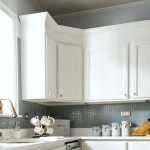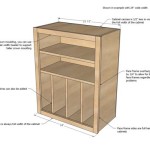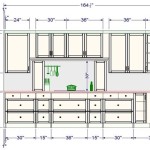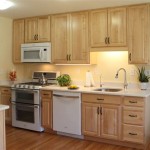Stripping And Refinishing Oak Kitchen Cabinets
Oak kitchen cabinets, known for their durability and distinctive grain patterns, are a common feature in many homes. However, over time, the finish on these cabinets can become worn, discolored, or simply outdated. Stripping and refinishing oak cabinets offers a viable and often cost-effective alternative to replacing them entirely. This process, while requiring time and effort, can breathe new life into a kitchen, updating its aesthetic and potentially increasing the home's value.
The procedure involves removing the existing finish, preparing the wood surface, and applying a new finish. Achieving a professional-looking result requires careful planning, the right tools and materials, and a methodical approach. Each step plays a critical role in the final appearance and longevity of the refinished cabinets.
Before commencing the project, meticulous planning is crucial. This includes assessing the current condition of the cabinets, determining the desired final appearance, and gathering all necessary supplies. Taking the time to plan thoroughly will help ensure a smoother and more successful refinishing project.
Assessing Cabinet Condition and Planning
The initial step involves a thorough inspection of the cabinet surfaces. Look for signs of damage such as scratches, dents, stains, and peeling finish. Identify areas that require repair or special attention during the stripping and sanding process. This assessment will dictate the type of stripping agent and sanding techniques needed.
Consider the desired final appearance of the cabinets. Will the natural oak grain be enhanced with a clear finish, or will the cabinets be stained a different color? Research different stain and finish options to find a color and sheen that complements the kitchen's overall design. Obtain samples of stains and finishes and test them on a hidden area of the cabinet or a scrap piece of oak to ensure satisfaction with the final color and appearance.
Creating a detailed plan also includes determining the best workspace. A well-ventilated area, free from dust and debris, is essential. Covering the floor and surrounding surfaces with drop cloths will protect them from spills and sanding dust. Adequate lighting is also critical for observing the progress and identifying imperfections.
Finally, the plan should include a timeline for the project. Stripping and refinishing cabinets is a multi-step process that can take several days or even weeks, depending on the number of cabinets and the complexity of the desired finish. Allocate sufficient time for each step to avoid rushing and compromising the quality of the final result.
The Stripping Process
Removing the old finish is a critical step in the refinishing process. Several stripping methods are available, each with its own advantages and disadvantages. Chemical strippers, heat guns, and sanding are the most common approaches.
Chemical strippers work by softening the existing finish, allowing it to be scraped away. Follow the manufacturer's instructions carefully, as these products can be harsh and require proper ventilation and safety precautions. Apply the stripper evenly to the cabinet surface and allow it to dwell for the recommended time. Use a scraper to remove the softened finish, working in the direction of the wood grain. Multiple applications may be necessary for stubborn finishes.
Heat guns use hot air to soften the finish, making it easier to scrape away. Exercise caution when using a heat gun, as excessive heat can damage the wood. Keep the heat gun moving and avoid concentrating the heat on one area for too long. Use a scraper to remove the softened finish as it bubbles and peels.
Sanding can also be used to remove the old finish, but it is a more labor-intensive and time-consuming method. This method is best suited for removing thin layers of finish or for cleaning up residue after chemical stripping. Start with a coarse-grit sandpaper (e.g., 80-grit) and gradually move to finer grits (e.g., 120-grit, 180-grit) to smooth the surface.
Regardless of the stripping method used, it is essential to remove all traces of the old finish before proceeding to the next step. Failure to do so can result in an uneven finish and poor adhesion of the new stain and topcoat.
After stripping, clean the cabinet surfaces thoroughly with mineral spirits or denatured alcohol to remove any remaining residue. Allow the cabinets to dry completely before sanding.
Sanding, Repairing, and Preparing the Surface
After the old finish has been removed, sanding is necessary to create a smooth, even surface for the new finish. This step is crucial for achieving a professional-looking result.
Begin by sanding the entire surface with a medium-grit sandpaper (e.g., 120-grit) to remove any imperfections and smooth out the wood grain. Work in the direction of the grain to avoid scratching the wood. Pay close attention to edges and corners, as these areas are prone to damage.
After sanding with medium-grit sandpaper, switch to a finer grit (e.g., 180-grit or 220-grit) to further refine the surface. This step will create a very smooth surface that is ideal for staining or applying a clear finish.
Inspect the cabinets for any damage, such as dents, scratches, or cracks. Repair these imperfections before applying the new finish. Small dents can often be steamed out using a damp cloth and a hot iron. For larger dents or cracks, use a wood filler that matches the color of the oak. Apply the filler according to the manufacturer's instructions and allow it to dry completely. Sand the filled area smooth with fine-grit sandpaper.
Before applying the stain or finish, remove all sanding dust from the cabinet surfaces. Use a vacuum cleaner with a brush attachment to remove the bulk of the dust. Then, wipe the cabinets down with a tack cloth to remove any remaining dust particles. A tack cloth is a sticky cloth that is designed to pick up dust and debris from surfaces.
Proper surface preparation is essential for achieving a durable and attractive finish. Taking the time to sand and repair the cabinets thoroughly will pay off in the long run.
Once the surfaces are sanded and free of dust, consider applying a wood conditioner, especially if planning to use a stain. Wood conditioner helps to even out the porosity of the wood, preventing blotchy or uneven stain absorption. Apply the wood conditioner according to the manufacturer's instructions and allow it to dry completely before staining.
Masking off areas that should not be stained or finished, such as hinges or the inside of the cabinet boxes, is also critical to a clean and professional appearance. Use painter's tape to carefully mask off these areas before proceeding with the staining or finishing process.
The selection of staining and finishing products is also key to the final look of the oak cabinets. Water-based and oil-based products each have advantages and disadvantages. Water-based products dry faster and emit fewer fumes, but may not penetrate the wood as deeply as oil-based products. Oil-based products provide a richer color and may be more durable, but they require longer drying times and emit stronger fumes. Choose products that are compatible with each other and appropriate for the desired look and level of durability.
Consider also the sheen of the finish. Options range from matte to high gloss, and the choice is largely dependent on personal preference and the overall style of the kitchen. Matte finishes are more forgiving of imperfections, while high-gloss finishes offer a more dramatic and reflective look.

Refinishing Kitchen Cabinets Modern Refacing Made Easy Wisewood

Diy Staining Oak Cabinets Eclectic Spark

Tips Tricks To Paint Honey Oak Kitchen Cabinets Cottage Living And Style

How To Refinish Wood Cabinets The Easy Way Love Remodeled

Cabinet Refinishing An 8 Step Guide For Pro Painters Ppc

How To Refinish Wood Cabinets The Easy Way Love Remodeled

How I Updated My Oak Cabinets Without Paint By Using Briwax Easy Budget Kitchen Makeover Only 24

How To Paint Kitchen Cabinets Without Sanding Or Priming

How To Strip And Re Stain Kitchen Cabinets Clinton Township Mi Eason Painting

From To Great A Tale Of Painting Oak Cabinets
Related Posts








